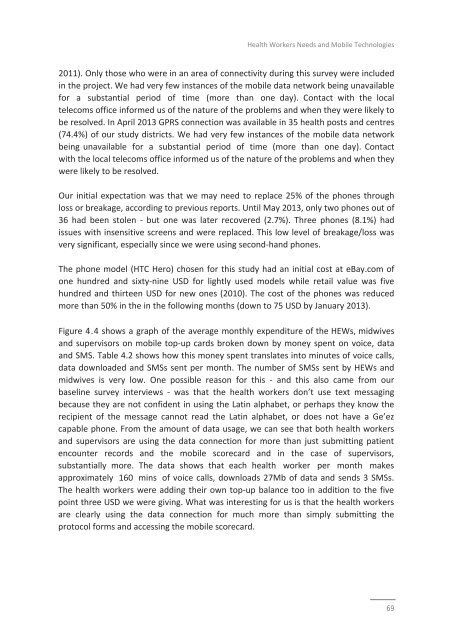araya-thesis
araya-thesis
araya-thesis
You also want an ePaper? Increase the reach of your titles
YUMPU automatically turns print PDFs into web optimized ePapers that Google loves.
Health Workers Needs and Mobile Technologies<br />
2011). Only those who were in an area of connectivity during this survey were included<br />
in the project. We had very few instances of the mobile data network being unavailable<br />
for a substantial period of time (more than one day). Contact with the local<br />
telecoms office informed us of the nature of the problems and when they were likely to<br />
be resolved. In April 2013 GPRS connection was available in 35 health posts and centres<br />
(74.4%) of our study districts. We had very few instances of the mobile data network<br />
being unavailable for a substantial period of time (more than one day). Contact<br />
with the local telecoms office informed us of the nature of the problems and when they<br />
were likely to be resolved.<br />
Our initial expectation was that we may need to replace 25% of the phones through<br />
loss or breakage, according to previous reports. Until May 2013, only two phones out of<br />
36 had been stolen ‐ but one was later recovered (2.7%). Three phones (8.1%) had<br />
issues with insensitive screens and were replaced. This low level of breakage/loss was<br />
very significant, especially since we were using second‐hand phones.<br />
The phone model (HTC Hero) chosen for this study had an initial cost at eBay.com of<br />
one hundred and sixty‐nine USD for lightly used models while retail value was five<br />
hundred and thirteen USD for new ones (2010). The cost of the phones was reduced<br />
more than 50% in the in the following months (down to 75 USD by January 2013).<br />
Figure 4.4 shows a graph of the average monthly expenditure of the HEWs, midwives<br />
and supervisors on mobile top‐up cards broken down by money spent on voice, data<br />
and SMS. Table 4.2 shows how this money spent translates into minutes of voice calls,<br />
data downloaded and SMSs sent per month. The number of SMSs sent by HEWs and<br />
midwives is very low. One possible reason for this ‐ and this also came from our<br />
baseline survey interviews ‐ was that the health workers don’t use text messaging<br />
because they are not confident in using the Latin alphabet, or perhaps they know the<br />
recipient of the message cannot read the Latin alphabet, or does not have a Ge’ez<br />
capable phone. From the amount of data usage, we can see that both health workers<br />
and supervisors are using the data connection for more than just submitting patient<br />
encounter records and the mobile scorecard and in the case of supervisors,<br />
substantially more. The data shows that each health worker per month makes<br />
approximately 160 mins of voice calls, downloads 27Mb of data and sends 3 SMSs.<br />
The health workers were adding their own top‐up balance too in addition to the five<br />
point three USD we were giving. What was interesting for us is that the health workers<br />
are clearly using the data connection for much more than simply submitting the<br />
protocol forms and accessing the mobile scorecard.<br />
69


